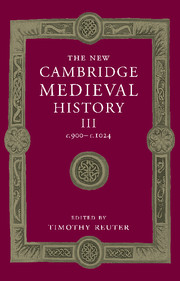Book contents
- Frontmatter
- 1 Introduction: reading the tenth century
- PART I GENERAL THEMES
- 2 Rural economy and country life
- 3 Merchants, markets and towns
- 4 Rulers and government
- 5 The Church
- 6 Monasticism: the first wave of reform
- 7 Intellectual life
- 8 Artists and patrons
- PART II POST-CAROLINGIAN EUROPE
- PART III NON-CAROLINGIAN EUROPE
- Appendix genealogical tables
- List of primary sources
- Bibliography of secondary works arranged by chapter
- Index
- Frontispiece
- Plate section
- Map 2: Archbishoprics and bishoprics in the early eleventh century
- Map 4: Germany
- Map 13: Byzantium in 1025
- References
3 - Merchants, markets and towns
from PART I - GENERAL THEMES
Published online by Cambridge University Press: 28 March 2008
- Frontmatter
- 1 Introduction: reading the tenth century
- PART I GENERAL THEMES
- 2 Rural economy and country life
- 3 Merchants, markets and towns
- 4 Rulers and government
- 5 The Church
- 6 Monasticism: the first wave of reform
- 7 Intellectual life
- 8 Artists and patrons
- PART II POST-CAROLINGIAN EUROPE
- PART III NON-CAROLINGIAN EUROPE
- Appendix genealogical tables
- List of primary sources
- Bibliography of secondary works arranged by chapter
- Index
- Frontispiece
- Plate section
- Map 2: Archbishoprics and bishoprics in the early eleventh century
- Map 4: Germany
- Map 13: Byzantium in 1025
- References
Summary
the beginnings of the European town in the form known to us from the late middle ages lie in the tenth century. Urbanism began its dynamic phase in the late eleventh century, reaching its climax in the thirteenth, but the basic elements were assembled between the decomposition of the Frankish empire at the end of the ninth century and the early decades of the eleventh. In this transitional period the commercial revolution began.
The renewed rise of the town as a social formation is certainly closely connected with the extension and intensification of trade: merchants are therefore an important group in the shaping of the medieval town, in its topography, its institutions and its social networks. Their activities were the most spectacular and impressive, and occasionally overshadow the contribution and activities of the other forces driving developments forward.
The rise in urban development and the changes in the structure and organisation of trade which will be described here presuppose a general expansion of the economy and an increase in prosperity, especially in the agrarian sector. This is the only explanation for the emergence of a broad stratum of consumers able to absorb the goods brought by long-distance trade. From the tenth century onwards this stratum was multi-layered, from clerics and aristocrats acquiring rich oriental cloth to wrap relics in, down to the Frisian manorial officials of the monastery of Werden on the Ruhr, who in the eleventh century had to make renders of pepper and wine to their clerical lords. And indeed the whole of Europe, including the Byzantine empire, shows an evident rise in agrarian production and demographic growth, though obviously there were variations between individual regions.
Keywords
- Type
- Chapter
- Information
- The New Cambridge Medieval History , pp. 64 - 94Publisher: Cambridge University PressPrint publication year: 2000
References
- 3
- Cited by

